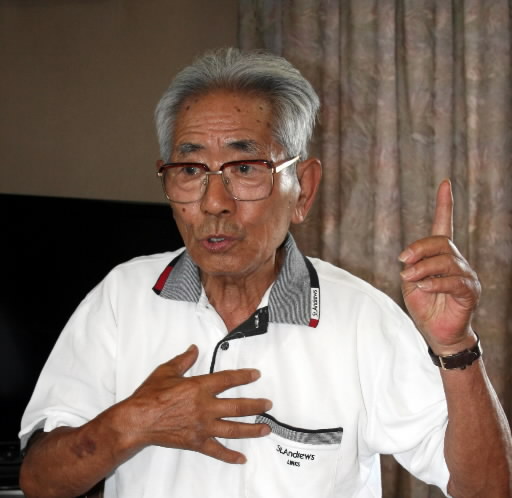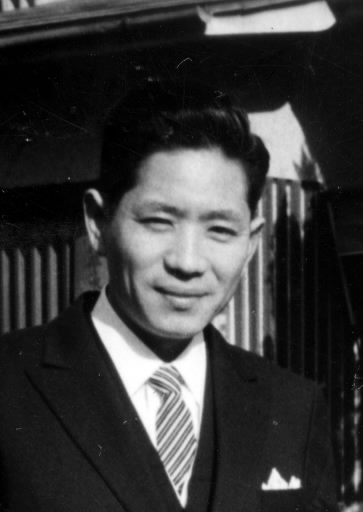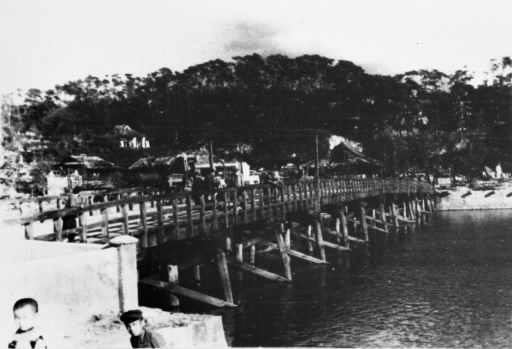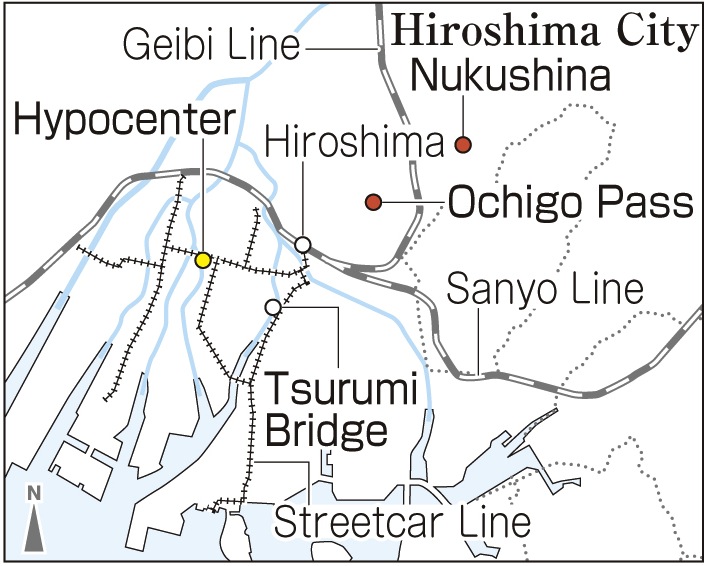Kazunori Nishimura, 80, Fuchu Town, Hiroshima
Aug. 1, 2013
Friends who rescued him died, but he survived
Continues to appeal for peace in their memory
Kazunori Nishimura, 80, experienced the atomic bombing near the east end of Tsurumi Bridge, about 1.7 kilometers from the hypocenter, in present-day Minami Ward. A classmate who was with him carried Mr. Nishimura on his back to safety. However, the following spring, when he returned to school, he learned that the classmate had passed away. “He died to save me,” Mr. Nishimura said. “I felt so sorry for him.” Burdened by remorse, he has endured by believing that he has a role to play in appealing to the next generation to preserve peace.
When the atomic bomb was dropped on the morning of August 6, 1945, Mr. Nishimura was 12 years old and in his first year of junior high school. With about 20 classmates, he was walking along the streetcar tracks of the Hijiyama Line from Hiroshima Station, in the direction of the Tanakamachi area in today’s Naka Ward, to help dismantle buildings to create a fire lane in the event of air raids. As they approached Tsurumi Bridge, he heard the sound of an American B-29 bomber diving. At that moment, he lost consciousness, and when he came to, he discovered that he was buried in debris.
Mr. Nishimura’s left leg was pinned between pieces of wood and he was unable to escape. He cried for help, but people were hurrying to flee and passing in front of him.
He began to feel the heat from flames raging closer. Thinking he would be burned to death in the fire, at the moment he had nearly given up he heard a voice: “Hey! Hang in there!” It was a soldier and he helped remove the debris.
Thanks to the soldier, Mr. Nishimura was now free, but he had been burned on the right side of his body and his hip was dislocated, so he couldn’t walk. He was laying on the ground, face up, when he heard someone call his name. He was unable to recognize the face, though, because the person’s skin had peeled away. “It’s me, Yanagida,” the person told him. Yanagida was the name of his classmate, his closest friend. Yanagida then put Mr. Nishimura on his back and the two of them, step by step, fled slowly away from the scene.
Along the way, they encountered another classmate, Nishikubo. The three boys went over Ochigo Pass, located in today’s Higashi Ward, and managed to reach Nukushina, also in Higashi Ward. The trek took four or five hours.
They rested there and spotted red tomatoes in a field. They were thinking of taking some tomatoes to ease their hunger, but Yanagida said, “I can’t eat them. I can’t eat anything. Am I going to die?” His mouth was blocked with the skin that had peeled from his cheeks and lips.
The boys spent the night at Nishikubo’s house, on the outskirts of the city. The next day, Mr. Nishimura returned, by train, to his home in the village of Kodani in Hiroshima Prefecture (part of present-day Higashihiroshima City).
In the spring of 1946, with the burns on his body healed, he returned to school with a walking stick. It was then that he learned his two classmates, the friends who had helped him flee, were both dead. That August, his father Yasukiyo passed away after his hair fell out and he showed other symptoms of radiation sickness. In the aftermath of the bombing, Yasukiyo had been searching for his son in the city center. “All the people who tried to help me have died,” Mr. Nishimura thought. “I’m the only one who survived.”
Mr. Nishimura still feels anger toward the United States. “The fact that they conducted an experiment like that on human beings is unforgivable,” he said. He hopes, though, that children will be able to appreciate the differences of language, culture, and ways of thinking, and work to resolve conflicts through dialogue. (Rie Nii, Staff Writer)
Tsurumi Bridge: Path of evacuation after the atomic bombing
Tsurumi Bridge spans the Kyobashi River at the east end of Peace Boulevard in the city of Hiroshima, about 1.7 kilometers from the hypocenter. The bridge links the Tsurumi-cho area in Naka Ward and the Hijiyama-honmachi area in Minami Ward.
The wooden bridge was constructed in 1880. When the atomic bomb was dropped over the city, on the west side of the bridge, there were 1,936 people from 12 schools, including the Hiroshima Girls' Commercial School and First Hiroshima Prefectural Junior High School, mobilized there for work, helping to dismantle buildings to create a fire lane. (Figures are from an exhibit held in 2004 at Hiroshima Peace Memorial Museum.)
Other people laboring in the area came from the Voluntary Army Fighting Corps of such areas as Onaga, Yaga, Kojin, and Danbara, as well as companies like the Toyo Kogyo factory (now, Mazda Motor Corporation). (Information obtained from documents on the war damage held by Hiroshima Prefecture.)
The bomb’s heat rays ignited the railings and other parts of the bridge, but the flames were quickly extinguished. Many survivors were then able to cross the bridge to seek refuge in Mt. Hijiyama and other areas.
At the east end of the bridge stands a large weeping willow that was able to endure the atomic bombing. However, in September 2007, when the tree was more than 100 years old, it was confirmed to have withered and died. Today, a newly born trunk from the same roots has appeared and is producing green leaves.
Teenagers’ Impressions
Because we’re alive, we can feel pain
Mr. Nishimura told us, “Because I’m alive, I feel pain and suffering. That’s proof I’m alive. If I were dead, I wouldn’t feel anything.” When something bad happens to me, I often complain about it. From now on, though, I want to appreciate the fact that I’m able to experience those things because I’m alive. (Shiho Fujii, 11)
Act with compassion for others
Mr. Nishimura’s friend, Mr. Yanagida, wasn’t able to eat the tomatoes that they found in the field that day. It must have been so painful for him. Just thinking about Mr. Nishimura’s feelings, when he saw his friend like that, almost brings me to tears. I admire Mr. Yanagida for what he did to help Mr. Nishimura and it made me think how important it is to act with compassion for others. (Minami Tanioka, 13)
Staff Writer’s Notebook
Mr. Nishimura was rescued by his best friend, Mr. Yanagida. Mr. Yanagida put Mr. Nishimura on his back, and panting heavily, carried away Mr. Nishimura to safety. Later, Mr. Nishimura heard that his friend had passed away after the bombing. Explaining his regret, Mr. Nishimura said, “Mr. Yanagida died because he rescued me. He shouldn’t have saved me.”
Even now, every time he sees a tomato, he is reminded of the sight of Mr. Yanagida’s face on August 6, 1945. Unable to eat the tomatoes they had found, his friend began to cry, tears trickling from his narrow eyes. He said he was afraid he would die.
Mr. Nishimura said with conviction: “When the peace constitution we have today was born, I expect everyone in Japan vowed ‘We’ll never wage war again so we won’t need a military or arms anymore.’ I want Article 9 to be preserved.” Back in elementary school, Mr. Nishimura admired soldiers and was taught to support them. “Japan is the divine nation” was what he was forced to believe, without a shred of doubt. This is why he feels peace education is so profoundly important. (Rie Nii)
(Originally published on July 23, 2013)
Continues to appeal for peace in their memory
Kazunori Nishimura, 80, experienced the atomic bombing near the east end of Tsurumi Bridge, about 1.7 kilometers from the hypocenter, in present-day Minami Ward. A classmate who was with him carried Mr. Nishimura on his back to safety. However, the following spring, when he returned to school, he learned that the classmate had passed away. “He died to save me,” Mr. Nishimura said. “I felt so sorry for him.” Burdened by remorse, he has endured by believing that he has a role to play in appealing to the next generation to preserve peace.
When the atomic bomb was dropped on the morning of August 6, 1945, Mr. Nishimura was 12 years old and in his first year of junior high school. With about 20 classmates, he was walking along the streetcar tracks of the Hijiyama Line from Hiroshima Station, in the direction of the Tanakamachi area in today’s Naka Ward, to help dismantle buildings to create a fire lane in the event of air raids. As they approached Tsurumi Bridge, he heard the sound of an American B-29 bomber diving. At that moment, he lost consciousness, and when he came to, he discovered that he was buried in debris.
Mr. Nishimura’s left leg was pinned between pieces of wood and he was unable to escape. He cried for help, but people were hurrying to flee and passing in front of him.
He began to feel the heat from flames raging closer. Thinking he would be burned to death in the fire, at the moment he had nearly given up he heard a voice: “Hey! Hang in there!” It was a soldier and he helped remove the debris.
Thanks to the soldier, Mr. Nishimura was now free, but he had been burned on the right side of his body and his hip was dislocated, so he couldn’t walk. He was laying on the ground, face up, when he heard someone call his name. He was unable to recognize the face, though, because the person’s skin had peeled away. “It’s me, Yanagida,” the person told him. Yanagida was the name of his classmate, his closest friend. Yanagida then put Mr. Nishimura on his back and the two of them, step by step, fled slowly away from the scene.
Along the way, they encountered another classmate, Nishikubo. The three boys went over Ochigo Pass, located in today’s Higashi Ward, and managed to reach Nukushina, also in Higashi Ward. The trek took four or five hours.
They rested there and spotted red tomatoes in a field. They were thinking of taking some tomatoes to ease their hunger, but Yanagida said, “I can’t eat them. I can’t eat anything. Am I going to die?” His mouth was blocked with the skin that had peeled from his cheeks and lips.
The boys spent the night at Nishikubo’s house, on the outskirts of the city. The next day, Mr. Nishimura returned, by train, to his home in the village of Kodani in Hiroshima Prefecture (part of present-day Higashihiroshima City).
In the spring of 1946, with the burns on his body healed, he returned to school with a walking stick. It was then that he learned his two classmates, the friends who had helped him flee, were both dead. That August, his father Yasukiyo passed away after his hair fell out and he showed other symptoms of radiation sickness. In the aftermath of the bombing, Yasukiyo had been searching for his son in the city center. “All the people who tried to help me have died,” Mr. Nishimura thought. “I’m the only one who survived.”
Mr. Nishimura still feels anger toward the United States. “The fact that they conducted an experiment like that on human beings is unforgivable,” he said. He hopes, though, that children will be able to appreciate the differences of language, culture, and ways of thinking, and work to resolve conflicts through dialogue. (Rie Nii, Staff Writer)
Hiroshima Insight
Tsurumi Bridge: Path of evacuation after the atomic bombing
Tsurumi Bridge spans the Kyobashi River at the east end of Peace Boulevard in the city of Hiroshima, about 1.7 kilometers from the hypocenter. The bridge links the Tsurumi-cho area in Naka Ward and the Hijiyama-honmachi area in Minami Ward.
The wooden bridge was constructed in 1880. When the atomic bomb was dropped over the city, on the west side of the bridge, there were 1,936 people from 12 schools, including the Hiroshima Girls' Commercial School and First Hiroshima Prefectural Junior High School, mobilized there for work, helping to dismantle buildings to create a fire lane. (Figures are from an exhibit held in 2004 at Hiroshima Peace Memorial Museum.)
Other people laboring in the area came from the Voluntary Army Fighting Corps of such areas as Onaga, Yaga, Kojin, and Danbara, as well as companies like the Toyo Kogyo factory (now, Mazda Motor Corporation). (Information obtained from documents on the war damage held by Hiroshima Prefecture.)
The bomb’s heat rays ignited the railings and other parts of the bridge, but the flames were quickly extinguished. Many survivors were then able to cross the bridge to seek refuge in Mt. Hijiyama and other areas.
At the east end of the bridge stands a large weeping willow that was able to endure the atomic bombing. However, in September 2007, when the tree was more than 100 years old, it was confirmed to have withered and died. Today, a newly born trunk from the same roots has appeared and is producing green leaves.
Teenagers’ Impressions
Because we’re alive, we can feel pain
Mr. Nishimura told us, “Because I’m alive, I feel pain and suffering. That’s proof I’m alive. If I were dead, I wouldn’t feel anything.” When something bad happens to me, I often complain about it. From now on, though, I want to appreciate the fact that I’m able to experience those things because I’m alive. (Shiho Fujii, 11)
Act with compassion for others
Mr. Nishimura’s friend, Mr. Yanagida, wasn’t able to eat the tomatoes that they found in the field that day. It must have been so painful for him. Just thinking about Mr. Nishimura’s feelings, when he saw his friend like that, almost brings me to tears. I admire Mr. Yanagida for what he did to help Mr. Nishimura and it made me think how important it is to act with compassion for others. (Minami Tanioka, 13)
Staff Writer’s Notebook
Mr. Nishimura was rescued by his best friend, Mr. Yanagida. Mr. Yanagida put Mr. Nishimura on his back, and panting heavily, carried away Mr. Nishimura to safety. Later, Mr. Nishimura heard that his friend had passed away after the bombing. Explaining his regret, Mr. Nishimura said, “Mr. Yanagida died because he rescued me. He shouldn’t have saved me.”
Even now, every time he sees a tomato, he is reminded of the sight of Mr. Yanagida’s face on August 6, 1945. Unable to eat the tomatoes they had found, his friend began to cry, tears trickling from his narrow eyes. He said he was afraid he would die.
Mr. Nishimura said with conviction: “When the peace constitution we have today was born, I expect everyone in Japan vowed ‘We’ll never wage war again so we won’t need a military or arms anymore.’ I want Article 9 to be preserved.” Back in elementary school, Mr. Nishimura admired soldiers and was taught to support them. “Japan is the divine nation” was what he was forced to believe, without a shred of doubt. This is why he feels peace education is so profoundly important. (Rie Nii)
(Originally published on July 23, 2013)











